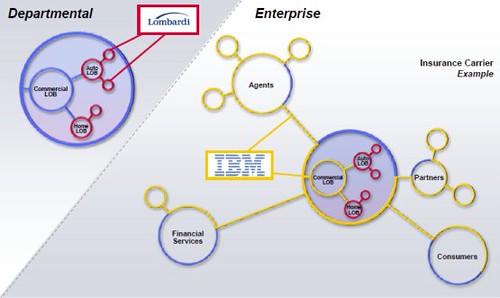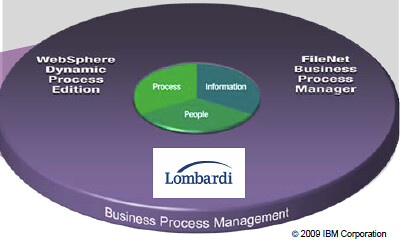There is no doubt IBM has been trying to make its own business process management system tooling more like Lombardi's for a year now... But they could never really grab hold of Lombardi's secret sauce, the "shared model."... Positioning that approach as "departmental" is a losing strategy...

I would describe IBM's briefing on last month's purchase of business process management (BPM) vendor Lombardi as predictably unrevealing, except for the fact that the acquired firm will be brought into WebSphere/AIM instead of being hung out to dry on its own like FileNet. So I guess we're down to the punditry...
My take is this was bound to happen. I'm sure Lombardi has rebuffed any number of BPM suitors over the years, insisting on an eventual IPO. But in today's market, that exit must have looked farther away than ever, so Phil Gilbert and company could forget all about the past Evil Empire bashing and just take the money (amount undisclosed).The functional overlap between the Lombardi and IBM BPM systems is obvious. I am not optimistic about the positioning, and I doubt they have even figured it out yet. Who can forget the business about "content-centric" vs "process-centric" BPM at the time of the FileNet acquisition? In the slide deck IBM sent out, a couple graphics seem to be following that same kind of thinking.

Here, for example, IBM is BPM for the Commercial LOB, the Financial Services arm, the Agent network, etc. Lombardi is BPM for one branch of the Commercial LOB, actually for the little circles (departments?) hanging off it. Enterprise vs Departmental. It says it right there on the slide.
The next one is even worse.

BPM involves process (Websphere), information (FileNet), and people (Lombardi). Now we have a separate BPMS for each of those. Isn't that great? Ummm, no.
Okay, to be fair, I'm going to assume the IBM marketing guys found out about this a couple days before the deal happened, and this is what they could throw together for the announcement.
Usually IBM is very slow to integrate its BPM-related acquisitions, e.g. FileNet or ILOG. They just add to the list of stuff that the professional services guys can integrate for you. Webify was the counter-example. Renamed WebSphere Business Services Fabric, it was just jammed into the middle of the WebSphere BPMS, even though it retained a completely separate metamodel, vocabulary, and toolset. It confused the heck out of everybody.
I think IBM would be better off adopting a strategy similar to Oracle's when they bought BEA. Again, two BPMSs, one more human-centric and the other more integration-centric. But instead of just adding to the list of products you could buy, Oracle aggressively went after technical integration, melding BEA's vastly more business-friendly tooling with Oracle's strength on the runtime backend.
There is no doubt IBM has been trying to make its own BPMS tooling more like Lombardi for a year now. Business Space and some of the human task features in v6.2 and v7 are a testament to this. But they could never really grab hold of Lombardi's secret sauce, the "shared model." What you model is what you execute, instant playback from the design environment, agile iterative design and deploy... WebSphere BPMS just doesn't work that way.
Positioning that approach as "departmental" is a losing strategy, and I honestly doubt that in the end IBM will do that. The battle for enterprise BPM is about engaging the business at enterprise scale, not just IT. It's what Phil Gilbert has been preaching for years, and I don't think IBM would have coughed up the money if they didn't believe it, too. So the trick is melding Lombardi's superior business-friendly tooling with IBM's bulletproof backend and SOA. BPMN 2.0 will provide them a way to do that, so I think today's positioning slides are just placeholders.
But then again, they didn't ask me.There is no doubt IBM has been trying to make its own business process management system tooling more like Lombardi's for a year now... But they could never really grab hold of Lombardi's secret sauce, the "shared model."... Positioning that approach as "departmental" is a losing strategy...
About the Author(s)
You May Also Like





